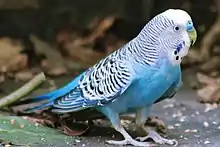

A parakeet is any one of many small to medium-sized species of parrot, in multiple genera, that generally has long tail feathers.
Etymology and naming
The name parakeet is derived from the French word perroquet, which is reflected in some older spellings that are still sometimes encountered, including paroquet or paraquet. However, in modern French, perruche is used to refer to parakeets and similar-sized parrots.[1]
In American English, the word parakeet usually refers to the budgerigar, which is one species of parakeet.
Summary

Parakeets comprise about 115 species of birds that are seed-eating parrots of small size, slender build, and long, tapering tails. The Australian budgerigar, also known as "budgie", Melopsittacus undulatus, is probably the most common parakeet. It was first described by zoologists in 1891. It is the most popular species of parakeet kept as a pet in North America and Europe.

The term "grass parakeet" (or grasskeet) refers to many small Australian parakeets native to grasslands such as the genus Neophema and the princess parrot. The Australian rosellas are also parakeets. Many of the smaller, long-tailed species of lories may be referred to as "lorikeets". The vernacular name ring-necked parakeet (not to be confused with the Australian ringneck) refers to a species of the genus Psittacula native to Africa and Asia that is popular as a pet and has become feral in many cities outside its natural range.
In aviculture, the term "conure" is used for small to medium-sized parakeets of the genera Aratinga, Pyrrhura, and a few other genera of the tribe Arini, which are mainly endemic to South America. As they are not all from one genus, taxonomists tend to avoid the term. Other South American species commonly called parakeets include the genus Brotogeris parakeets, the monk parakeet, and lineolated parakeets, although lineolateds have short tails.
A larger species may be referred to as "parrot" or "parakeet" interchangeably. For example, "Alexandrine parrot" and "Alexandrine parakeet" are two common names for the same species, Psittacula eupatria, which is one of the largest species normally referred to as a parakeet.
Many different species of parakeets are bred and sold commercially as pets, the budgerigar being the third most popular pet in the world,[2] after cats and dogs.
Breeding
Parakeets often breed more readily in groups; however, there can be conflicts between breeding pairs and individuals especially if space is limited. The presence of other parakeets encourages a pair to breed, which is why breeding in a group is better. Despite this, many breeders choose to breed in pairs to both avoid conflicts and know offspring's parentage with certainty. Parakeets lay an average of 4-8 eggs, while budgerigars (a species of parakeet) lay an average of 4-6 eggs.
European population
Belgian population
As of 2023, an estimated 10,000 parakeets lived in Brussels, the capital of Belgium. The total made them one of the most populous birds in the city, behind only pigeons and sparrows.[3]
Spain's parakeet control measures
According to a 2018 report, Spanish authorities drew up plans to curb the ever-growing population of parakeets, which reached 30,000 in locations such as Malaga.[4]
United Kingdom
In December 2019, Steven Le Comber, of Queen Mary University in London, UK, published an analysis in the Journal of Zoology based on geographic profiling methods. It concluded that the thriving rose-ringed parakeet population in the United Kingdom had grown from numerous small-scale accidental and intentional pet releases. Previous theories had included a pair released by Jimi Hendrix on Carnaby Street and an arrival in 1951 when Humphrey Bogart and Katharine Hepburn visited London with various animals to film The African Queen, set in the equatorial swamps of east Africa.[5][6]
See also
References
- ↑ "Quelles différences entre un perroquet et une perruche ?". Le Mag des Animaux. Retrieved 2023-02-11.
- ↑ Perrins, Christopher, ed. (2003). "Parrots, Lories, and Cockatoos". The New Encyclopedia of Birds (1 ed.). Oxford: Oxford University Press. ISBN 9780198525066.
- ↑ Gross, Jenny (2023-11-10). "How Tropical Birds Took Over This European Capital, Bringing a 'Splash of Color'". The New York Times. Retrieved 2023-11-10.
- ↑ Strange, Hannah (2018-11-23). "Plan to use snipers to control parakeet population draws anger in Spain". The Telegraph. ISSN 0307-1235. Archived from the original on 2022-01-12. Retrieved 2020-02-02.
- ↑ "Hendrix? Hepburn? Study busts myths about origins of UK's parakeets". The Guardian. 12 December 2019. Archived from the original on 12 December 2019. Retrieved 12 December 2019.
- ↑ "Jimi Hendrix cleared of blame for UK parakeet release". BBC News. BBC. 12 December 2019. Archived from the original on 12 December 2019. Retrieved 12 December 2019.